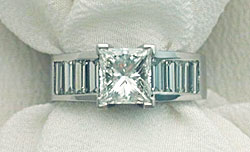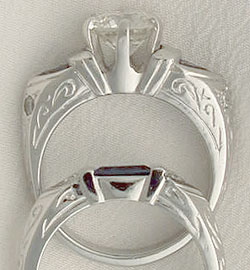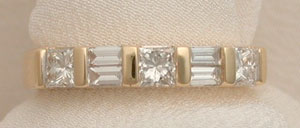  |
||||||||||||||||||||||||||||||||
| Education
Click on any of the links below to take you to additional information about the subject listed. Please don't hesitate to call or drop us a note if you have any more questions.
Diamonds are one of nature’s most enduring and valuable treasures. The word alone calls to mind all sorts of images, from songs and movies, to that special sparkle that only a precious, brilliant cut diamond can produce.
You may know that there are also some relatively “new” ones. In 1953, research scientists at GE created the first man-made diamonds using conditions that approximated those under the earth’s crust: 3 million pounds of pressure per square inch and 9000 degrees. They were small and of poor quality, and although the technique has improved, synthetic diamonds are still not a viable alternative to natural ones. HISTORY The diamond rush was on, and every European nation was represented, creating chaos around the newly discovered ancient volcanic pipes. Cecil Rhodes, the son on an English clergyman, sailed to South Africa with hopes of improving his health. Well, at least his fortune improved: he started at the mines selling ice and water to the other diggers, and by 1900 ended up controlling 90% of the world’s production of round diamonds (his company, DeBeers, controls about 60% today). But he died young, at the age of 48, and left his vast fortune to Oxford University (creating the Rhodes scholarship). Today, diamonds are found in several countries in Africa, and there are large mines in Australia and Russia. There are new mines in Canada, and diamonds have even been discovered in the U.S. (Virginia, Louisiana, Michigan, California), as well as the largest one ever found in North America: the Uncle Sam diamond was found in Arkansas in 1924 and weighed in at a whopping 40 carats. As long as we’re talking about size, the largest crystal ever found was the size of a fist. The Cullinan was mined in South Africa in 1905, weighed 3,106 carats, and was cut into 9 major gems and 96 smaller ones. The two largest are in the British crown jewels, and the remaining were given to the diamond cutter as payment!
Diamonds are durable. Nothing is as hard as diamond and it takes another diamond to scratch one. If set properly, a diamond can be worn for years and be handed down to the next generation in excellent condition. Diamonds are relatively very rare, and the only reason we see so many of them is due to the Herculean efforts used to unearth them! Depending on the type of mining, on the average, 20 tons of earth yield 4 carats of rough crystal, of which 1 carat is gem quality — and almost half of that is lost in cutting! WHAT TO LOOK FOR
Clarity: This refers to internal as well as external irregularities. A feather and an included crystal (often incorrectly referred to as a “carbon spot”) are examples of internal irregularities. An external one might be chip, or an abrasion at the edge of a facet. The Gemological Institute of America's grading system is the worldwide standard, and includes 11 levels, from Flawless (no irregularities that are visible to a trained grader under 10x magnification) to Imperfect 3 (inclusions that seriously affect the beauty and durability of the stone). I should add that inclusions, especially ones that cannot be seen without magnification, can be an asset in identifying a stone, as well as in lowering its price. In general, the better the clarity, the rarer the stone, the more valuable it is. Color: By far, the most popular color for diamond is no color at all. Technically, very few are truly colorless. Most diamonds we see have trace amounts of nitrogen which give them a slight yellow tint, but this is often difficult to see. A colorless diamond starts at “D” on the GIA scale, with E and F almost as rare. G-H-I-J are considered nearly colorless, and many stones you see are in this range. As you go farther down the alphabet, it progresses more yellow or brown until the end where it then starts to change to fancy colored yellows and then the value starts to rise. Actually, diamonds come in all colors including pink, green, blue, gray, even black. Red is very rare: a 0.95 carat red diamond was auctioned at Christie’s in 1987 for $800,000. But violet is the rarest of all. The first one ever documented was seen just this year, weighing in at 1ŕ2 carat. Cut: I believe, in general, that cut is the most important factor. A large, colorless crystal with excellent clarity can look like a lifeless piece of glass if it’s not cut well, while a small, tinted crystal with some inclusions minimized by a skillful cutting job can result in a beautiful stone. I’ve used extreme examples here, and in reality it depends on the diamonds in question and the preferences of the customer. On the more technical side, the round brilliant cut with its 58 facets is by far the most popular shape, but the Princess cut (basically a square version of the round brilliant cut) and the Marquis cut (like a thinner football) are often requested. And there are several more shapes with their own beauty and distinctive character. These are shapes of diamonds, but the aspect of cut I was referring to before that relates to the scientific placement of facets … how well the cutter was able to bring out the crystal's brilliance (reflection of bright, white light), dispersion (breaking up the light into spectral hues), and scintillation (those sparkling flashes); in effect, how much beauty was revealed. The Fifth “C”: I know, “customer service” is an overused term but I could think of no better way to describe what we do. Instead of trying to sell you a diamond out of the showcase, or the biggest diamond we can, we take a different approach. With diamonds as in everything else we do, we start with you: What are you looking for? Some people know exactly what they want; others don’t think they have even a clue; some only know what they don’t want. We’re always able to narrow down the choices. Not until then do we start looking for the right stone. It may seem like a subtle difference, but it’s the best way to insure you’ll be happy with your selection. And customers who don’t know us well are encouraged to shop around. That’s how confident we are. We enjoy taking an experience some people expect to be somewhat stressful, and turn into something pleasant — even fun — as it should be! |
||||||||||||||||||||||||||||||||
© 2008 - Refined Designs Original Fine Jewelry | All rights reserved | 518-765-3750 |
||||||||||||||||||||||||||||||||
 Diamonds
formed about 100 miles under the earth’s crust and were brought to
the surface, via volcano. Next time you look at a diamond, consider
its age: the first ones were brought to the surface over 2.5 billion
years ago, and even the most recent are about 50 million years old!
Diamonds
formed about 100 miles under the earth’s crust and were brought to
the surface, via volcano. Next time you look at a diamond, consider
its age: the first ones were brought to the surface over 2.5 billion
years ago, and even the most recent are about 50 million years old! WHY
THEY'RE SO SPECIAL
WHY
THEY'RE SO SPECIAL  ABOUT
THE FOUR “C's”
ABOUT
THE FOUR “C's”